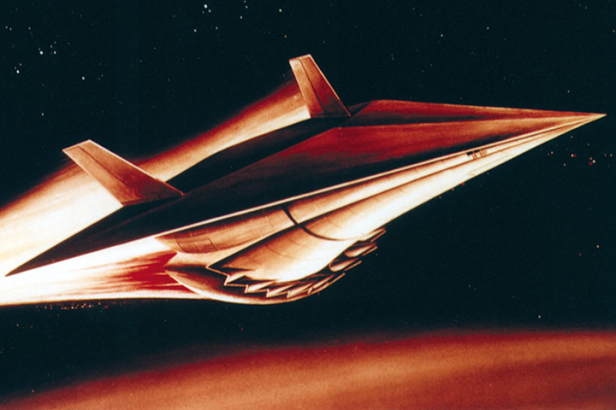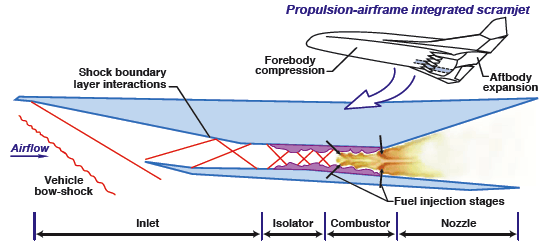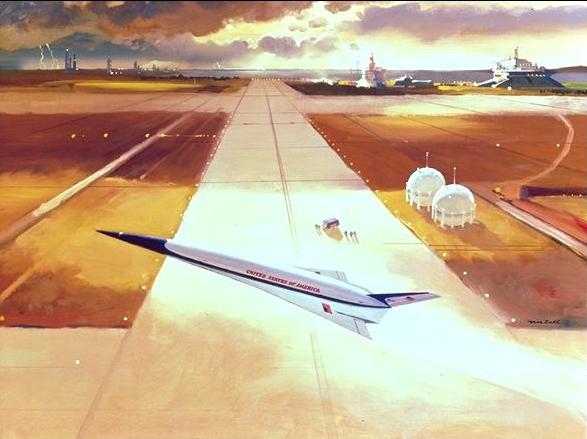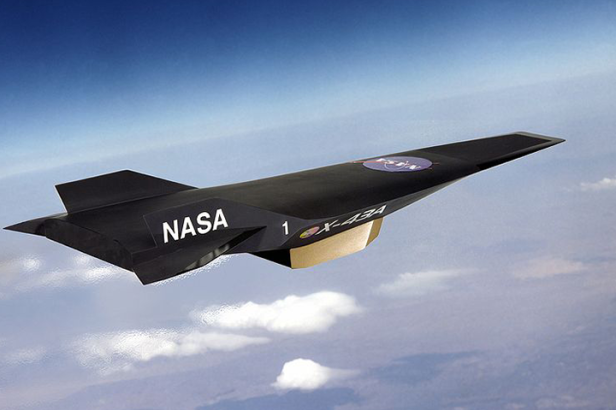On February 4th 1986, mere days after the United States had been shocked by the Challenger disaster, President Reagan rose before Congress to give his State of the Union Address. “We’re going forward with our shuttle flights. We’re going forward to build our space station. And we are going forward with research on a new Orient Express that could, by the end of the next decade, take off from Dulles Airport, accelerate up to 25 times the speed of sound, attaining low Earth orbit or flying to Tokyo within 2 hours.”
Reagan’s ‘Orient Express’ was not a new idea, but his announcement allowed a project from the Black world of classified budgets to step into the light. His words had been carefully chosen to emphasise the potential for a new era of rapid transit for the general public but in reality the National Aerospace Plane (NASP) as the project was officially christened, was being designed with a very different role in mind and promised the fulfilment of a dream that stretched all the way back to the late 1950’s.
The NASP represented just the latest attempt to attain one of the holy grails of aviation, the Single Stage to Orbit (SSTO) vehicle. SSTO has been a hugely seductive concept for aerospace designers since the 1950’s. The idea of being able to access space with a vehicle that is completely re-usable and therefore promises massive economic benefits, holds a clear attraction. Couple this with thoughts of a steady evolution from high speed and high altitude aviation, leading to a true aerospace plane that can take off and fly into orbit before landing horizontally on a runway and it’s easy to see why the idea receives periodic revisits.
But for all of the apparent elegance and simplicity that SSTOs seem to offer there are good reasons why none have yet flown. The problems of creating such a vehicle are daunting, requiring huge leaps in the state of the art regarding propulsion, materials and design and testing techniques. There is also one major stumbling block for an SSTO – by its very nature it must carry the entire vehicle weight into orbit and back again, meaning such designs are extremely sensitive to increases in weight or reductions in performance that may occur in the detailed planning stages.
To understand why Reagan’s advisors though the concept was workable in the mid 1980’s we first need to go back to a little known Air Force initiative to provide routine, affordable orbital access.
The Air Force Aerospaceplane
Even as the space age was in its earliest stages in 1957, some within the United States Air Force were beginning to turn their thoughts to how the existing expendable boosters could be recovered and reused as a way of lowering the costs involved in placing payloads in orbit. Initially these ideas revolved around adding wings to existing designs such as the Convair Atlas, but as new technologies and requirements developed, more ambitious plans began to take shape. Initiated by Weldon Worth, Director at the Air Force’s Aero Propulsion Laboratory (APL), the Aerospaceplane project (initially just called Spaceplane) sought to bring together emerging ideas around high speed propulsion and lifting airframes to create an SSTO to deliver Department of Defence (DoD) payloads to orbit with aircraft-like operations.

Under the Aerospaceplane project Convair, Martin, Boeing, Lockheed, North American and Goodyear all worked on initial feasibility studies before creating a wide variety of design solutions for what seemed a workable SSTO. Initial projections were for an operational system within the 1966-68 timeframe, but unsurprisingly there were huge technical hurdles between paper designs and a practical vehicle. While LACE and ACES seemed to offer practical approaches under test conditions, a full-size system was never constructed and ramjet research was stagnating due to the growing realisation that speed and height was no longer a defence for bombers and interceptors. The cancellation of projects such as the Republic XF-103 combined cycle interceptor had a knock on effect for SSTOs.
Beyond the technical issues, more practical problems dogged the Aerospaceplane. The Air Force was unable to provide a clear operational need for the project at a time when they had Atlas and Titan ICBMs capable of providing orbital access. Coupled with this they were also pursuing a winged Boost/Glide vehicle, the Dyna Soar which would have overlapped with many of the proposed roles for an Aerospaceplane. (To see more about the X-20 Dyna Soar CLICK HERE)
Given the hugely ambitious nature of the project, it was unsurprising that 1963 saw the official cancellation of Aerospaceplane, but some activities did carry on beyond this point in the hope that an air launched sub-scale demonstrator could still fly. But one key technology considered for the Aerospaceplane did survive to become a focus for the projects that followed – the supersonic combustion ramjet or Scramjet.
Scramjet Developments
As the demands for propulsive performance increased during the 1950’s with designers seeing speed and altitude as the ultimate for winged vehicles, so new ways were sought to provide air-breathing alternatives to limited duration rocket propulsion. The ramjet had held much early promise, but rapidly the capabilities of turbojets coupled with efficient inlets provided Mach 3+ performance, negating much of the need for ramjets. The problems for air breathing propulsion came above these speeds and this is where the scramjet came in.
Designed to work in the range between Mach 3 and, theoretically at least, orbital velocities of Mach 25, the scramjet takes advantage of the speed of the airflow to compress the air prior to combustion but whereas a ramjet must decelerate this air to subsonic speeds prior to combustion, a scramjet allows supersonic flow throughout the engine.
Most early scramjet designs were axisymmetric – essentially they were podded engines with a circular inlet channeling airflow around a centre body. During the 1960’s various experimental scramjet programmes were run by the US Navy and Air Force (under the APL) but early results were not encouraging. Small models were able to achieve ignition and thrust, but the drag the axisymmetric configuration produced cancelled this out meaning they were unable to produce net thrust – clearly an issue for an effective propulsion system.
As work moved forward to improve scramjet configurations, plans were made for flight test vehicles. By this time, the United States already had a hypersonic research craft, the North American X-15, and plans were submitted to modify one of the three flight articles into a more advanced scramjet testbed. Opportunity to action these ideas came as a result of a serious crash involving the number 2 aircraft during an emergency landing in November 1962. Although badly damaged, the decision was made to rebuild and modify this craft to a new configuration, the X-15A-2. This more advanced vehicle allowed for additional propellants to be carried for both the main XLR-99 engine and an additional scramjet test article to be carried on the lower ventral fin. This engine was known as the Hypersonic Research Engine (HRE) and was to be built by Garret AiResearch under the direction of Tony DuPont. DuPont was a member of the famous chemical manufacturing family and had impressed Garret and NASA with his proactive and innovative approach to requests for an HRE design.

While the HRE was foundering, studies at NASA’s Langley Centre were investigating a very different scramjet configuration. A podded axisymmetric scramjet would never be able to take advantage of the majority of the air flowing past a vehicle’s body making the design inefficient. The new research examined placing scramjets with simpler rectangular inlets across the lower section of the vehicle’s body, meaning the shape of the vehicle would form part of the propulsive system by compressing the incoming air ahead of the inlet, then shaping the exhaust aft of the scramjet’s nozzle. Struts within the inlets could act as fuel injectors as well as structural elements, making a far simpler design which would become the characteristic configuration for all scramjet powered vehicle proposals that would follow.

Star Wars and COPPER CANYON
Following Ronald Reagan’s election victory in 1980, the new administration began to look at potential responses to the Soviet Nuclear arsenal. Although new weapons building programmes were initiated to allow an equivalent nuclear response to any attack, other strategies were also under consideration. The concept of a new space based system for missile defence, capable of nullifying the Soviet threat, became popular within the National Security Council and over the coming years this concept developed into the Strategic Defence Initiative (SDI) announced by Reagan in 1983 and more commonly known as Star Wars.
Clearly any such system would require regular and reliable orbital access. Initial estimates suggested at least 100 new items vehicles would be placed in orbit although this was seen as highly conservative with some commentators claiming over 2000 new satellites could be required. Concurrently, some within the DoD were beginning to question the Air Force’s commitment to the Shuttle. While Air Force payloads and involvement had been vital in making the case to develop the Shuttle, by 1982 it was becoming clear that it was not going to provide the routine easily maintainable transportation system that had originally been pitched. There were also concerns about the safety of the system with a damaging 1982 study by the RAND corporation predicting that up to 3 of the Shuttle fleet may be lost during the operational life of the programme. (For more on the Air Force’s role in the design of the Shuttle CLICK HERE)
Against this backdrop the DoD began to cast around for potential alternatives including a spaceplane of their own. The Air Force Aeronautical Systems Division (ASD) started work on an initiative for a Shuttle replacement that became known as the Trans Atmospheric Vehicle (TAV) programme, but elsewhere the Defence Advanced Research Projects Agency (DARPA) was also showing an interest.
DARPA had originated during the Eisenhower administration in 1958 as the Advanced Research Projects Agency (ARPA) to provide a means for promoting scientific and technological research in the wake of Sputnik. Having been heavily involved in the initial American responses to Soviet space successes, the agency later broadened its remit to cover all areas of technology including the initial development of what would become the Internet.
During the early 1980’s DARPA Director Robert Cooper remained interested in Aerospace projects and through his encouragement of the advanced propulsion field came into contact with Tony DuPont. Since his involvement with the HRE, DuPont had continued his work on advanced propulsion systems and by 1982 felt he had found a way through many of the problems that had previously dogged scramjet developments. Finding a receptive audience in Cooper, DuPont was put in contact with leading DARPA aerodynamicist Robert Williams. Between them DuPont and Williams began working on a series of investigations into an SSTO vehicle featuring a combined cycle propulsion system utilising scramjets. By 1984, these initial steps appeared to show great promise and subsequently grew into a classified project named COPPER CANYON – an attempt to show how routine reliable access to space could be developed to support the needs of the SDI.
The key goals for COPPER CANYON were to provide a vehicle capable of taking off and landing horizontally on a standard runway and able to reach orbit as and when required, delivering or retrieving payloads. To do this it would need not only an advanced combined-cycle propulsion system, but also a means to deal with the extreme aerodynamic heating created by speeds up to Mach 25. DuPont proposed that this could be achieved by using the Hydrogen fuel carried to power the scramjets. By passing this around the structure of the vehicle, much of the heat could be carried away from the surfaces. Other predicted advances in heat resistant materials and Computational Fluid Dynamics (CFD) would allow the creation of a vehicle that was both robust yet light enough to endure these extreme velocities and return intact and ready to fly again with a minimum of post-flight processing.
COPPER CANYON represented Phase 1 of the programme, concluding with the production of a baseline design an air-breathing SSTO vehicle. The next stage was to invite manufacturers onboard to propose how they would develop the key technologies required to make it a reality and to do this COPPER CANYON needed to shed it’s classified status, take on a new identity and go public.
Selling the dream

In using the term “Orient Express” and highlighting the benefits of such a vehicle as a rapid intercontinental transport, the administration were being slightly economical with the truth. Early concept art showed a dart shaped craft in colourful airliner style livery to help sell this idea, but in reality aviation analysts were quick to recognise NASP’s primary role – as an SSTO to support SDI and related initiatives. Certainly, the same technologies could be used to produce the next generation of air travel but attempts to interest airlines in lending their to NASP produced very little in the way of commitment from this sector.
Moving the programme out of the Black and into the public realm allowed NASA to become fully involved. They became one of the project partners alongside the Air Force, Navy, Strategic Defence Initiative Organisation (SDIO) and DARPA. Overall control of the program would continue to rest with DARPA with an estimated 80% of funding coming from DoD budgets. What NASA were able to bring was a huge amount of knowledge in, as well as facilities to test, many of the key areas highlighted under Phase II, namely:
- Advanced Airbreathing Propulsion
- Advanced Materials
- Computational Fluid Dynamics
- Actively Cooled Structures
Initial estimates for the project using the baseline design developed under COPPER CANYON were extremely optimistic with Tony DuPont suggesting a 50,000 pound vehicle within 5 years for $5bn. Following Reagan’s announcement, slightly more conservative timescales were developed with a heavier vehicle aiming for flight tests in the late 1990’s. Initial research contracts for Phase II were divided between airframe and propulsion contractors were let during 1986. Rockwell International, McDonnell Douglas, General Dynamics, Boeing and Lockheed received airframe contracts and General Electric (with Aerojet TechSystems) and Pratt & Whitney received the propulsion contracts. Rocketdyne also elected to enter the propulsion contest using their own funds.


As Phase II development continued, the design gradually evolved from the sleek delta-winged circular cross-section wing/body model proposed by DuPont into a far larger rectangular cross section blended lifting body. As the size increased and performance remained marginal, so some of the potential missions began to fall away. High inclination or Polar orbits no longer appeared achievable – taking with them a key factor in the NASP’s usefulness to the DoD.

By 1992, although development continued, the project was still some distance away from a set of workable solutions to take into Phase III – the design and construction of the X-30 Flight article. An additional phase (II-E) lasting three years was suggested to construct scale models for flight test. The early confidence that CFD could accurately model flight conditions between the Mach 8 attainable in test facilities and the Mach 25 required for orbital flight appeared less well founded now and it seemed prudent to test in flight prior to a commitment to build a full size X-30.
Dates for a first flight of the full-sized vehicle began to push into the next century and the Air Force, recognising the NASP programme was a huge drain on their shrinking resources and an asset they no longer required, decided to withdraw support leading to the eventual termination of the programme.
At the time of the NASP’s cancellation in 1995 an estimated $5.5 billion had already been spent (although given that much of this came from DoD sources this may well not be accurate). Moving to Phase III could well have tripled this spend and there was no consensus that all of the problems could have been solved. At the end of the programme many advances had been made in terms of materials and CFD techniques but there was still no workable SSTO design.
Conclusions
It’s difficult to look at NASP and not conclude that some sort of collective wishful thinking settled upon the decision makers at DARPA and the DoD. The concept seemed so logical and to offer so many advantages over the Shuttle or existing expendable launchers that it’s understandable it could gain support, but as Ivan Bekey, formerly a Senior Engineer with NASA’s Office of Exploration and a seasoned SSTO advocate observed ”Being airplane-like the NASP concept attracted powerful backing because it was intuitively easy to grasp. The nation fooled itself into believing that because the NASP image was what was desired, the reality itself was therefore attainable.”
Former head of the Lockheed Skunk Works Ben Rich was somewhat more forthright in his assessment of NASP. “Reagan called [NASP] the ‘Orient Express’ because it would fly from New Your to Tokyo in only two hours. Reagan wanted to build it in four to eight years. He’d be lucky to do it in fifty” adding “…whoever dreamed up that Presidential address ought to be canned.”
Both COPPER CANYON and NASP could certainly have done with a severe dose of realism and far greater due diligence of the challenges involved and project risks they posed prior to moving forward. It’s unrealistic to base any engineering project, especially one as revolutionary as an SSTO spaceplane, so firmly on best case scenarios. The techniques and materials required were far beyond ‘state-of-the-art’ even a decade after the project’s genesis and the conventional wisdom in aerospace design – that weight will always increase as a design develops – seems to have been disregarded.

The high profile of NASP and repeated assertions that the technology was within the reach led many to speculate that the whole project had been a front for a classified vehicle. The shadow of the mythical Aurora looms large over many aerospace projects and given NASP’s stated goals it seemed like a good fit for many secret plane watchers. In reality, there is little in the NASP project documentation to suggest that a hypersonic spy plane could have been produced much quicker than the X-30. A scramjet powered craft of the projected size of the X-30 would certainly be a fairly conspicuous presence in the skies!
In the wake of the NASP failure the SSTO dream still persisted as a way to replace the Shuttle in the longer term. The SDIO moved to a very different approach with the McDonnell Douglas DC-X, a vertical takeoff and landing rocket demonstrator that produced impressive results during the early 1990’s. NASA also looked to a different approach with the X-33, a vertical takeoff horizontal landing lifting body which started development in the mid 1990’s and was to lead to the privately operated VentureStar. (For more on the story of the X-33 CLICK HERE)

More recently, the X-51 was able to achieve longer duration hypersonic cruise using it’s scramjet engine and although the proposed follow on vehicle, Blackswift, was cancelled a new generation of hypersonic weapons look set to benefit from the lessons learned from these projects.
As for an air-breathing SSTO, current attention has shifted to the British Reaction Engines Ltd SKYLON project with it’s revolutionary SABRE propulsion system, but where this promising project goes remains to be seen.
Hopefully the costly lessons of NASP will be heeded.
Sources
The X-Planes: X-1 to X-45 – Jay Miller
Facing the Heat Barrier: A History of Hypersonics – T.A. Heppenheimer
Critical Issues in the History of Spaceflight: Chapter 9 “A failure of National Leadership” Why no replacement for the Space Shuttle – John M. Logsdon
Space Shuttle: The History of the National Space Transportation System – Dennis R. Jenkins
Secret Projects: Military Space Technology – Bill Rose
Aerospace Projects Review: Volume 2, Number 5
Report of the Defence Science Board on National Aerospace Plane Program – November 1992
Skunk Works – Ben R. Rich & Leo Janos


Chris, I just want to say that your articles are great reads. You’ve compiled some great detailed information coupled with some good sourced opinions to create some very interesting articles. I will definitely be continuing to read your blog.
LikeLike
Thank you for sharing
LikeLike